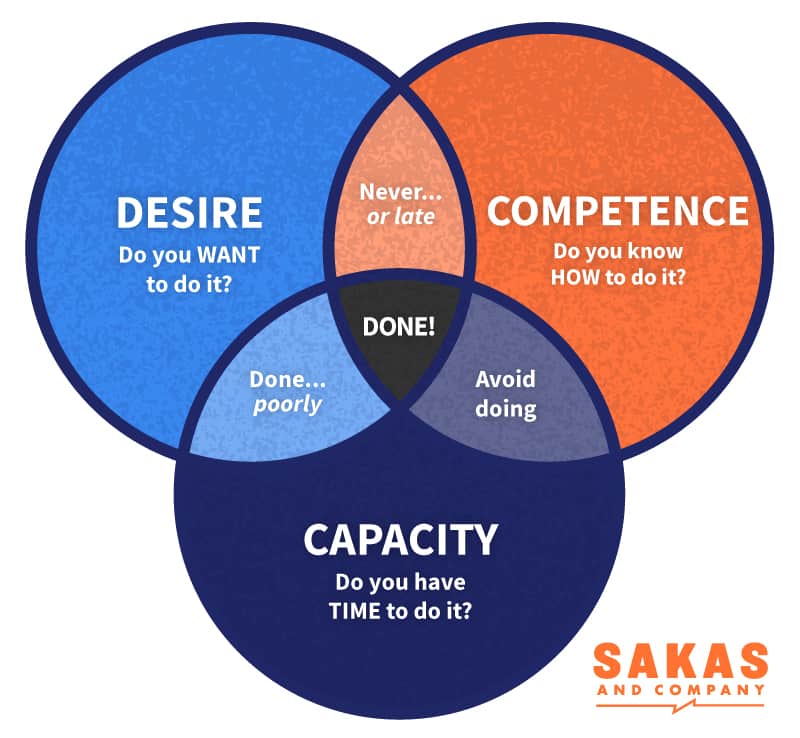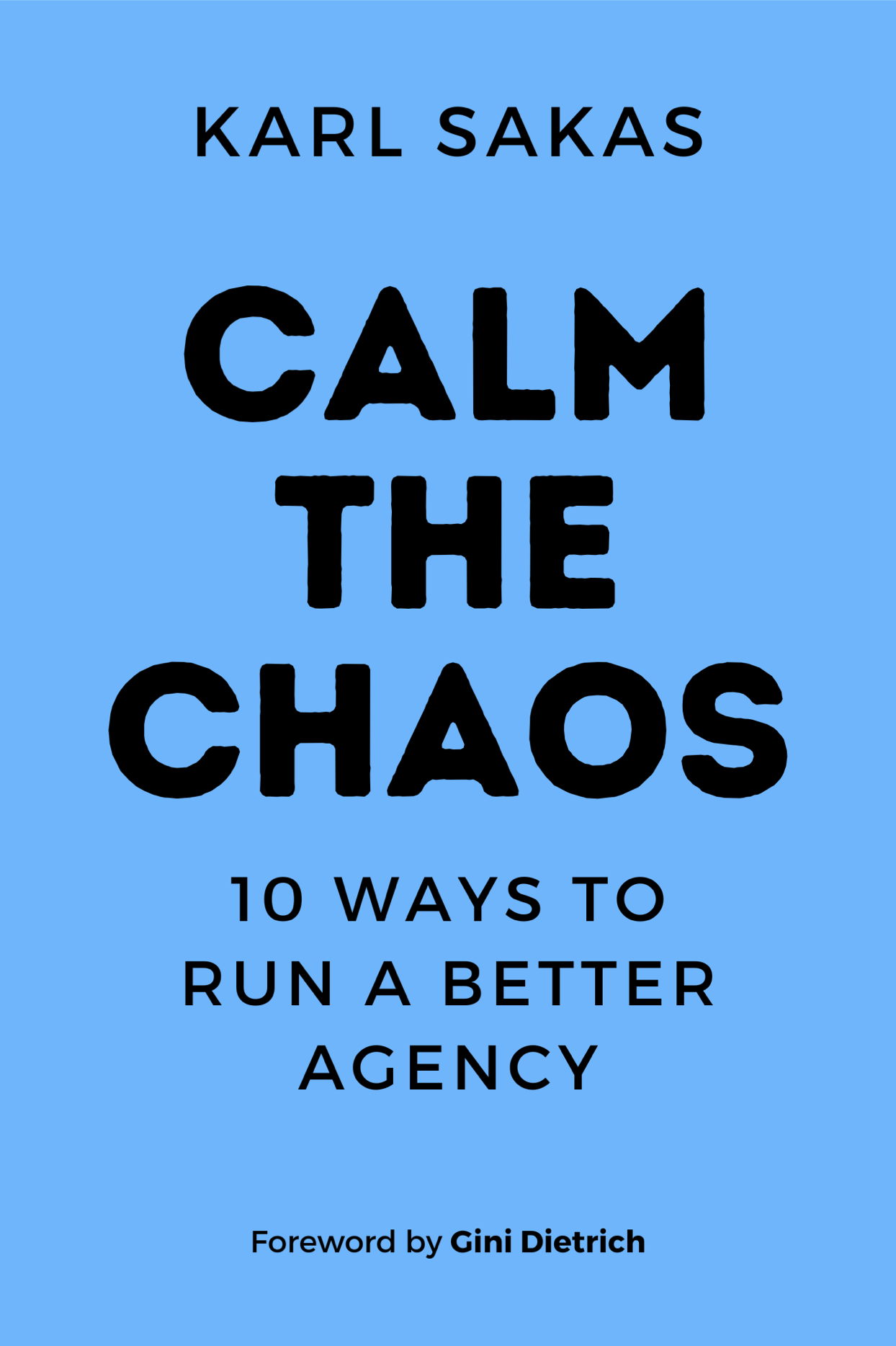
Frustrated things aren’t getting done? Consider my Desire, Competence, and Capacity model. (larger)
Frustrated that an employee isn’t completing their important assignments? Or maybe you’re the one struggling as the overloaded agency leader?
Perhaps you’ve told someone—or yourself—“Just do it!” That’s a good slogan for Nike, but it’s not good advice for the chronically stuck.
Running an agency is more complicated than following a reductive sports slogan—but you can solve this, with the right approach!
To get unstuck, use my agency consulting model for troubleshooting a “not done” situation: Desire, Competence, and Capacity.
NOTE: After I created the Venn diagram in my client work, a client said it reminded them of “Get it, Want it, and Have the capacity to do it” (GWC) from EOS. I hadn’t seen the EOS phrasing before, but I can see the similarities.
Three Requirements to Get Things Done
When important things aren’t happening, it’s often because you don’t have three key factors. I describe them as follows:
- Desire (Do you WANT to do it?)
- Competence (Do you know HOW to do it?)
- Capacity (Do you have TIME to do it?)
You can use my Desire/Competence/Capacity model to fix things. Let’s look at how these often misalign at agencies.
Three Mismatches… and Just One Match
There are three ways to go wrong… and just one way to go right. To help you troubleshoot, let’s look at the four combos!
Failure #1: Competence + Capacity, but not Desire
This is the “reluctant employee“—they can do it and they have time to do it, but they choose not to do it. It’s not always a conscious choice on their part—but you ultimately aren’t getting what you need from them.
Dig into understanding the “why” behind their lack of desire.
- If it’s not part of their core job, consider reassigning the task to someone else on the team.
- If it’s part of their core job, that’s a problem. For instance, this might be an Account Manager who doesn’t like clients, or a Project Manager who doesn’t like the Iron Triangle.
If an employee lacks Desire to do a core part of their job, they need to be in a different job—whether at your agency or somewhere else.
And if you’re the one lacking Desire, assign it to someone else. (With some exceptions—you shouldn’t delegate vision or setting the culture, and you still need to manage your direct reports.)
Failure #2: Desire + Capacity, but not Competence
When someone has Desire and Capacity but not Competence, it’s a dangerous combination. Why? Because things get done, but they get done poorly. And without oversight, you may not notice the quality problem until it’s too late.
You can address this via a combination of candidate screening, employee onboarding, and quality control. You—or your middle managers—need to keep an eye on things, rather than assume.
For instance, I was delegating my email newsletter to a new team member. The process is not necessarily hard, but it’s complex—and a mistake would reflect poorly on my brand.
- To train her, I recorded a screen-share on how to do it, where I explained the goals and nuances.
- She then created written documentation.
- As a final “check,” I asked her to record a screen-sharing as she scheduled the email in queue, so I could double-check.
- I reviewed the screen-share video, and everything’s on track—and I gave her the approval to proceed for future weeks.
Failure #3: Desire + Competence, but not Capacity
I see happen to agency leaders a lot—you want to do it (Desire) and you can do it (Competence) but you lack the time (Capacity). And thus your to-do list grows.
Sometimes it’s a matter of resetting how you spend your time. Other times, it’s enlisting others to help with some or all of the work.
In coaching, I help agency owners set monthly goals that contribute to their long-term goals. (As Stephen Covey said, “Begin with the end in mind.”) Narrowing their to-do list to what’s most important—and ensuring the goals are S.M.A.R.T. goals—helps people focus.
My goal-setting process also includes clients setting a Reward and a Consequence. This “gamification” gives people an extra nudge, because it’s a reward and a consequence they chose.
Success = Desire + Competence + Capacity
Here’s where it all aligns!
- When you (or a team member) have Desire and Competence and Capacity, things tend to get done. They get done, and they get done well.
- If you’re struggling—or you see one of your direct reports struggling—try using the Desire/Competence/Capacity model to troubleshoot the situation.
Using the three-factor model also helps you reduce the sense of blame. If someone isn’t doing something, it’s usually not that they’re a terrible person—they’re just missing 1-2 key factors. If they’re willing to address those, you can move forward together.
Applying “Desire, Competence, Capacity” at Your Agency
If you’re chronically struggling to do something, try applying my “Desire, Competence, and Capacity” model to the situation. Do you have all three factors… or are 1-2 missing?
If one of your team members is often struggling, you can use the same process with them. (But keep in mind that not everyone feels comfortable volunteering if they have a Desire or Competence problem, and “martyr complex” employees don’t like to tell the boss they have a Capacity problem.)
Keep in mind that there may be other issues, too—medical, psychological, or a lack of resources. And if something is impossible—or effectively impossible based on your agency’s Values, Goals, and Resources—then it’s never going to happen. Other times, you need to choose to defer things.
Sometimes you’ll need to step back and decide whether to pursue—or perhaps modify—the goal, or perhaps to reassign the work to someone who has Desire, Competence, and Capacity. (If it’s currently on your plate, all the better to make yourself “Needed but not necessary.”)
Whatever the specific outcome, use this model to help people get unstuck so you can get back to the fun parts of agency life!
Question: How can you use my Desire/Competence/Capacity model to get unstuck at your agency?


